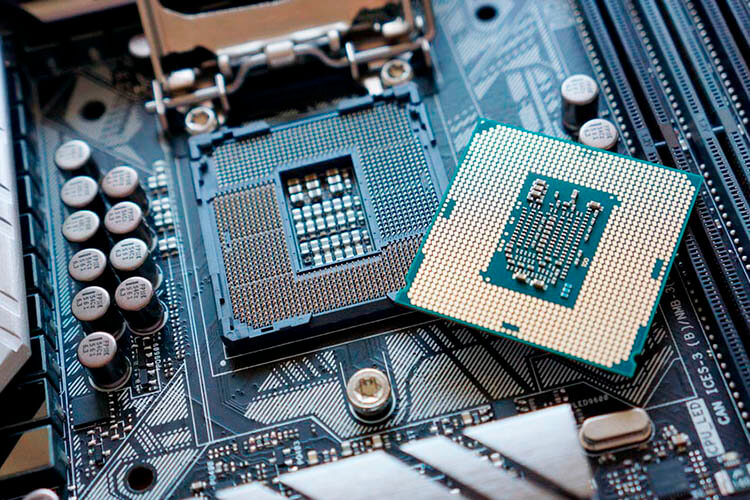Top 15 best 1151 socket processors: ranking 2024-2025 and how to choose a powerful processor for games
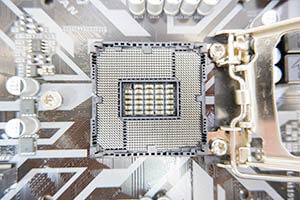 Socket is the processor socket, with which the crystal is connected to the computer or any other device.
Socket is the processor socket, with which the crystal is connected to the computer or any other device.
When choosing a processor, first of all, it is taken into account, and only then - all other characteristics.
Below is a list of the top 15 processors to consider for 2024-2025 and which chips are best suited for the 1151 socket.
Top 15 Processors for Socket 1151 in 2024-2025
The ranking includes the best processors for socket 1151 v1 for the year 2024-2025. Here you can find both expensive and budget models.
| Place | Name | Price |
|---|---|---|
| Top 5 best socket 1151 processors by price/quality for 2024-2025 |
||
| 1 | Intel Core i3-7100 | Check price |
| 2 | Intel Celeron G3930 | Find out the price |
| 3 | Intel Celeron G3900 | Find out the price |
| 4 | Intel Core i5-7500 | Find out the price |
| 5 | Intel Core i3-6100 Learn the price | Find out the price |
| Top 5 Gaming Processors for 1151 Socket | ||
| 1 | Intel Core i7-7700K | Find out the price |
| 2 | Intel Core i7-7700 | Find out the price |
| 3 | Intel Core i5-7400 | Find out the price |
| 4 | Intel Core i5-6400 Learn the price | Find out the price |
| 5 | Intel Core i3-7320 | Find out the price |
| Top 5 best budget 1151 socket processors | ||
| 1 | Intel Pentium G4560 | Find out the price |
| 2 | Intel Pentium G4400 | Find out the price |
| 3 | Intel Core i3-7350K | Ask the price |
| 4 | Intel Xeon E3-1220 v6 | Find out the price |
| 5 | Intel Core i5-7600K | Find out the price |
Synopsis of
How do I choose a 1151 socket processor?
If the processor has the right socket, you should pay attention to its other characteristics, so that in the work it is fully satisfied.
In 2024-2025, there are at least 5 of these characteristics, and here is the list:
- Nuclear Performance. The more cores and threads, the better.
- Tech Process. Here the principle of inverse proportionality applies: the smaller the process technology, the better.
- Clock speed. This is the frequency of the processor in normal load mode. The higher the number, the better.
- Turbo Boost speed - is the maximum frequency of the processor when overclocked. The higher the figure, the better the crystal performs in multitasking mode or at maximum load (e.g. when running heavy games).
- Heat dissipation. The "golden mean" is TDP 65W.
Top 5 CPUs for 1151 socket by price/quality for 2024-2025
The crystals in this selection are suitable for universal computer systems for the home or office, as well as for devices that will be used by different people for different tasks.
Intel Core i3-7100
The dual-core chip with Hyper-Threading technology is capable of handling up to four computing threads and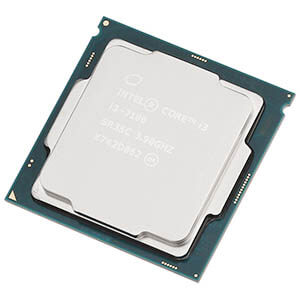
But user reviews say that in combination with a powerful graphics card, this chip makes a great gaming system.
The chip is designed with 14 nm processor, which is reliable, fast, but giving up its position in 2024-2025. The core has Kaby Lake microarchitecture. Layer 3 cache capacity is 3 MB.
In general, the processor is characterized by performance, good operating frequency and energy efficiency - even under heavy load it does not heat up or noise, and in peak activity TDP does not exceed 51W.
Technical specifications:
- core performance: 2/4;
- process technology: 14 nm;
- Operating frequency: 3900 MHz;
- TDP: 51W.
- brisk;
- inexpensive;
- integrated graphics;
- no heat or noise;
- supports DDR4 memory.
- Difficult to find a driver;
- 2 cores.
Intel Celeron G3930.
Budget processor with two cores and two processing threads for LGA 1151 is good for home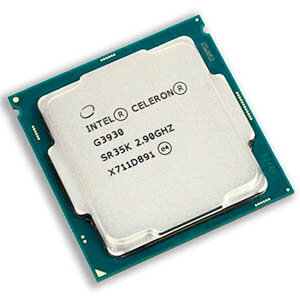
The crystal is characterized by good performance at minimum load, fixed clock speed of 2900 MHz, no turbo mode and locked multiplier. The model doesn't heat up, consumes negligible amount of power, doesn't make noise, has small L3 volume (2 Mb) and supports DDR4-2133 memory.
This processor is not compatible with Intel Optane Memory and Intel vPro technology.
Specifications:
- Core counts: 2/2;
- process technology: 14nm;
- operating frequency: 2900 MHz;
- TDP: 51W.
- performance;
- budget;;
- built-in video core;
- memory controller.
- No cooler included;
- 2 cores.
Intel Celeron G3900.
This budget entry-level platform is good for tablets and home computers, which do not require great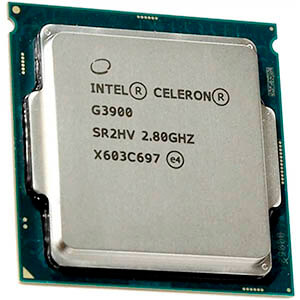
The processor has 2 cores and 2 threads, 14 nm process technology and a clock frequency of 2800 MHz and is rightfully considered one of the most economical Intel chips. Its strong point is a good integrated video core, which can replace a discrete graphics card.
In operation, the processor keeps the clock frequency 2800 MHz, no heat, noise and does not require powerful cooling. The desktop chip has 2 MB of built-in L3 cache, supports DDR4 memory, and due to the improved video core is able to support 4K monitors at 60 Hz.
Specifications:
- Core performance: 2/2;
- process technology: 14 nm;
- working frequency: 2800 MHz;
- TDP: 51 W.
- performance speed;
- price;
- Built-in graphics quality;
- does not heat up;
- power efficiency.
- none.
Intel Core i5-7500.
Great all-purpose desktop CPU with four cores and the same number of processing threads counts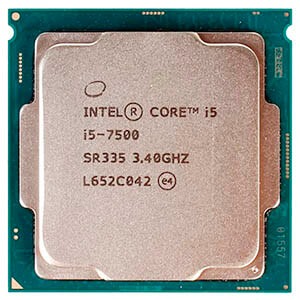
It does not support simultaneous multithreading technology (hyperthreading), but not bad in speed with high power efficiency, minimal heat and quietness.
Working frequency of the cores on the Kaby Lake microarchitecture is 3400 MHz. In the booster, the frequency increases to 3800 MHz. The integrated video core Intel HD Graphics 630 is very good: it is suitable for multimedia and gaming due to the frequency of 1.1 GHz and a maximum memory size of 64 GB.
The processor supports 64-bit bit.
Technical specifications:
- Core performance: 4/4;
- 14nm process technology;
- operating frequency: 3400 MHz;
- TDP: 65W.
- Intel vPro support;
- overclocking potential;
- clock speed;
- cold;
- dual-channel memory.
- Thermal paste under the lid.
Intel Core i3-6100
The quad-core processor with Hyper-Threading technology is an excellent alternative to the quad-core Intel Core i5 and i7 families at a lower price.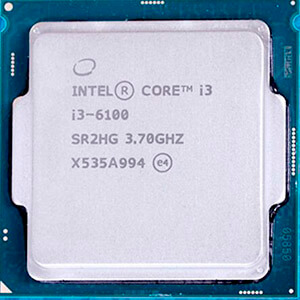
The cores are based on the Skylake microarchitecture. The maximum heat dissipation is 51 TDP, so a simple cooler is provided as a cooling system in BOX package.
Level 3 cache memory is 3 MB for all cores. DDR4 and DDR3L are announced as supported memory. Both controllers function in dual channel mode and the claimed memory capacity is 64 GB.
Specifications:
- Core performance: 2/4;
- Process technology: 14 nm;
- Operating frequency: 3700 MHz;
- TDP: 51W.
- L3 cache size;
- quiet;
- cool;
- it has its own graphics.
- were not detected.
Top 5 Gaming Processors for Socket 1151
Gaming processors are valued primarily for their operating frequency and overclocking potential.
Intel Core i7-7700K
Quad core CPU with 8 threads on performance and speed is as good as six-core crystals of the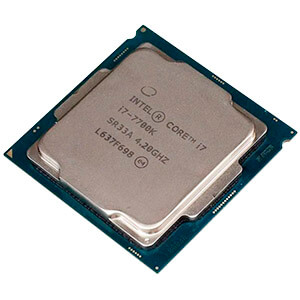
When actively working in normal mode the temperature does not rise above 41 degrees, and even when overclocked to the maximum 5 GHz processor is not heated, does not noise and does not require a more powerful cooling system than standard coolers from Intel.
The crystal excels at gaming and watching video, both at Full HD and 1440p.
It adapts well to the top graphics cards and shows itself in high load mode, but for those who do not need modern games and the maximum power of the computer, this processor will be useless: the potential of the chip will simply not be used.
Technical specifications:
- core performance: 4/8;
- process technology: 14 nm;
- operating frequency: 4200 MHz;
- TDP: 91W.
- performance speed;
- overclocking potential;
- The amount of L3 cache 8 MB;
- built-in graphics core.
- no cooler included;
- heat dissipation.
Intel Core i7-7700
CPU with four cores on Kaby Lake microarchitecture, which is not far from the usual Skylake cores. In comparison with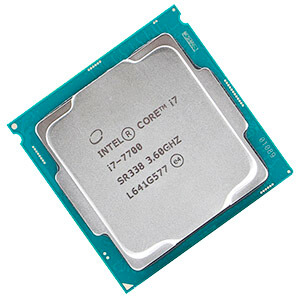
When operating in auto acceleration mode, the frequency increases to a maximum of 4200 MHz. The multiplier of this chip is locked.
Despite the increased frequency, the heat dissipation remains on a low level - this is the main advantage of the crystal. A cooler with one 90 or 120 mm fan is enough for cooling. The tests showed that even in stress mode the temperature does not rise above 50 degrees.
Integrated graphics Intel HD Graphics 630 can become a full replacement for a discrete graphics card. With the same processor combines very well with integrated graphics cards, pulls resource-intensive games, heavy applications and quality video files.
Technical specifications:
- Core performance: 4/8;
- process technology: 14 nm;
- operating frequency: 3600 MHz;
- TDP: 65W.
- performance speed;
- overclocking potential;
- The amount of L3 cache 8 MB;
- built-in graphics core;
- dual-channel memory.
- Not compatible with 3xx series chipsets.
Intel Core i5-7400
One of the most affordable gaming processors in the Core i5 lineup with four kaby Lake cores and 8 processing threads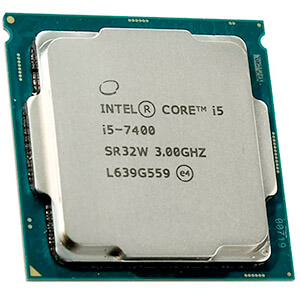
At maximum load, the clock speed falls just a little short of the maximum and stays at about 3.3 GHz, but at lower load, the claimed 3.6 GHz are achieved without any problems. At the same time, with increasing speeds, the operating voltage decreases if you compare the chip with competitors.
Level 3 memory cache is 6 MB. Built-in memory controller works in dual channel mode with DDR4-2400 MHz and DDR3L-1600 MHz modules with a maximum capacity of 64 GB of RAM.
The Intel HD Graphics 630 graphics core performs well and can work even when three monitors are connected, using all the allowable amount of RAM.
Specifications:
- Core performance: 4/8;
- 14nm process technology;
- operating frequency: 3600 MHz;
- TDP: 65W.
- performance speed;
- overclocking potential;
- L3 cache size: 8 MB;
- integrated graphics core;
- dual-channel memory.
- Not compatible with 3xx series chipsets.
Intel Core i5-6400
An excellent performance-price ratio processor for gamers and those who deal with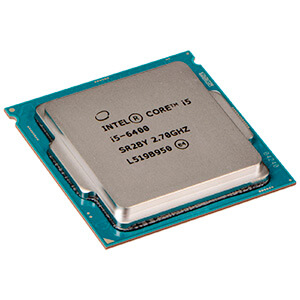
The CPU has 4 cores and the same number of dedicated threads. It is a budget solution on the SkyLake microarchitecture baja with integrated graphics, capable of replacing a discrete graphics card. The model is compatible with dual channel DDR4/DDR3L RAM.
This chip is enough to solve the daily user tasks even without the Hyper-Threading technology, which is not present in the chip. It has a capacious 6 MB cache, is very energy efficient and has an Intel HD Graphics 530 video core with a full-fledged driver.
Specifications:
- nuclear scores: 4/4;
- process technology: 14 nm;
- operating frequency: 2700 MHz;
- TDP: 65W.
- performance;
- support for DDR4 memory;
- built-in graphics;
- does not heat up;
- rugged.
- poor overclocking potential.
Intel Core i3-7320.
Inexpensive CPU, capable of power and performance to replace more expensive crystals of the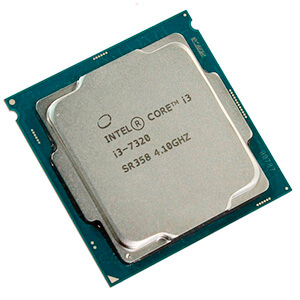
In spite of the presence of only two cores in the microarchitecture Kaby Lake, this processor has a high clock speed of 4100 MHz and 4 MB cache, due to what is considered the most powerful in the family of Core i3 chips with locked multiplier.
The processor is well suited for universal home computers, for gaming systems with top motherboards and for multimedia devices. The model has 4 computing threads and Hyper-Threading system.
There is no turbo-boost mode, but at such a clock speed it is not really needed because it has only two cores. As RAM, the manufacturer offers to choose DDR4-2133/2400 or DDR3L-1333/1600.
Technical specifications:
- core performance: 2/4;
- process technology: 14 nm;
- Operating frequency: 4100 MHz;
- TDP: 51W.
- it does not heat up;
- noiseless;;
- efficient;
- integrated graphics core.
- poor overclocking potential.
Top 5 best budget socket 1151 processors
Budget processors feature reliability, good performance and low TDP.
Intel Pentium G4560.
Universal, relatively cheap CPU with two cores with Kaby Lake microarchitecture and Hyper-Threading technology can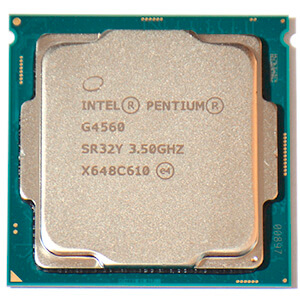
The chip features 14nm process technology, 3MB of L3 cache and a clock frequency of 3500MHz.
The chip is compatible to DDR4-2133/2400 and DDR3L-1333/1600 memory and has an integrated graphics core capable of playing back high resolution video, displaying the picture on the screen or on multiple monitors. More difficult tasks are beyond the power of the video core.
If you are considering a graphics processor for gaming systems, then only for high resolution games. A pleasant bonus to the owner of this crystal will be energy efficiency.
Technical characteristics:
- core indicators: 2/4;
- process technology: 14 nm;
- working frequency: 3500 MHz;
- TDP: 54 W.
- it does not heat up;
- noiseless;;
- performance;
- integrated graphics core;
- price;
- DDR3L, DDR4 memory support.
- 2 cores;
- not compatible with 3xx series chipsets.
Intel Pentium G4400
The dual-core processor with 2 computing threads is one of the simplest, most affordable and versatile crystals in the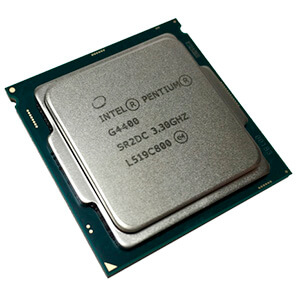
Hyper-Threading technology is not provided, neither is the AVE instruction set. On the whole, the processor proves itself perfectly in work with, say, office tasks, web surfing, simple work in graphics and text editors, but it is not worth betting on the built-in graphics core.
The CPU can handle multimedia playback, including 4K-format, but heavy video games are not up to the task.
The crystal supports dual-channel DDR4-memory with a frequency of 1333/1600/1866/2133 MHz and a maximum capacity of 64 GB. The cache volume is also modest - only 3 MB, and this is enough only for office tasks.
Technical specifications:
- core performance: 2/2;
- Process technology: 14 nm;
- operating frequency: 3300 MHz;
- TDP: 54W.
- works with Windows 7;
- fast;
- cool;
- DDR4 support.
- Not suitable for games.
Intel Core i3-7350K.
Powerful and efficient processor at an affordable price with an unlocked multiplier and a good operating frequency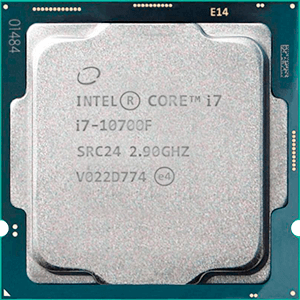
The chip has 14nm process technology and 2 cores on Kaby Lake microarchitecture with Hyper-Threading support: the number of threads is twice the number of cores. Despite the declared heat dissipation of 60 W, the CPU heats up considerably under high load and stress, so it is recommended to choose a powerful cooling system.
The processor is compatible with motherboards on the 100 and 200 chipset, has a built-in graphics core HD Graphics 630, which is able to cope only with the withdrawal of multimedia on the screen.
The weak side is the temperature when overclocking, and the strong side is the overclocking. Tests have shown that up to 5 GHz the processor can be overclocked with almost any video card and motherboard.
Technical specifications:
- cores: 2/4;
- process technology: 14 nm;
- operating frequency: 4200 MHz;
- TDP: 60W.
- good operating frequency;
- excellent integrated graphics;
- suitable for video editing and light gaming.
- You can pick up a 4-core analog for the same price.
Intel Xeon E3-1220 v6
A great all-round processor at an adequate price with four cores on the Kaby Lake microarchitecture. It lacks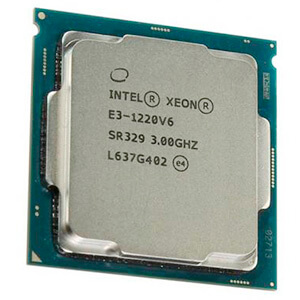
The crystal supports dual channel DDR4-2400, DDR3L-1866 memory with up to 64GB total capacity. With a claimed TDP of 72W, the chip shows excellent performance with high energy efficiency, minimal heating and almost silent operation.
If you choose a boxed configuration, you can forget about buying an additional cooling system: the standard fan will do its job.
The working frequency is 3000 MHz, in boost the crystal is overclocked up to 3500 MHz. This is a good indicator even for 2024-2025, but do not expect to run super modern demanding games.
The processor is productive, cool, well overclocked and supports Intel vPro, but experienced users recommend choosing newer crystals for a similar price, at least - with Hyper-Threading technology or integrated graphics.
Specifications:
- Core performance: 4/4;
- process technology: 14nm;
- operating frequency: 3000 MHz;
- TDP: 72W.
- performance;
- Intel vPro support;
- cache size;
- supports modules with ECC;
- does not heat up.
- none.
Intel Core i5-7600K.
An excellent quad-core processor with an unlocked multiplier for universal use - it is suitable for home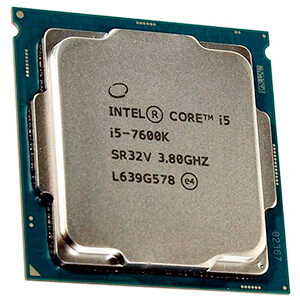
The performance of this CPU will be enough for most users. It will even be useful for multi-threaded applications due to its high clock frequency and roomy 6 MB cache (a plus for demanding programs).
There is no Hyper-Threading technology: the number of cores corresponds to the number of computing threads.
The manufacturer claims a heat output of 91 W, but any cooling tower system can handle such heat. At maximum load in the test, the processor heated up only to 53 degrees.
The integrated Intel HD Graphics 630 graphics core is great for multimedia, including relatively young games. The crystal overclocks smoothly and quickly with only a slight increase in voltage and does not heat up even at maximum load.
Specifications:
- Core performance: 4/4;
- process technology: 14 nm;
- operating frequency: 3800 MHz;
- TDP: 91W.
- It doesn't get warm even under heavy loads;
- Good frequency even without overclocking;
- power efficiency;
- built-in graphics.
- heat dissipation.
Conclusion and conclusions
For owners of motherboards with socket 1151 there is a huge choice of processors: simple, budget, premium, gaming. Knowing for what purpose the computer is going, you can choose a suitable crystal without much difficulty.
Customer reviews
Helpful video
How to choose the right processor:



